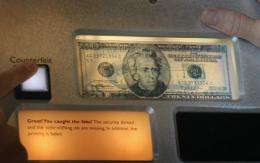Visitors try to pick counterfeit bills from the real ones displayed at the Money Museum in the Federal Reserve Bank of Chicago in 2011. Scientists have reported they had invented an invisible tag using the widely-used "quick response" code to help thwart banknote forgers and criminals who sell bogus drugs or fake vintage wine.
An invisible quick response (QR) code has been created by researchers in an attempt to increase security on printed documents and reduce the possibility of counterfeiting, a problem which costs governments and private industries billions of pounds each year.
Publishing their research today in IOP's journal Nanotechnology, the researchers from the University of South Dakota and South Dakota School of Mines and Technology believe the new style of QR code could also be used to authenticate virtually any solid object.
The QR code is made of tiny nanoparticles that have been combined with blue and green fluorescence ink, which is invisible until illuminated with laser light. It is generated using computer-aided design (CAD) and printed onto a surface using an aerosol jet printer. The development process can be viewed in this video:
According to the researchers, the QR code will add an increased level of security over existing counterfeiting methods as the complexity of the production process makes it very difficult to replicate.
The combination of the blue and green inks also enabled the researchers to experiment with a variety of characters and symbols in different colours and sizes, varying from microscopic to macroscopic. Embedding these into the QR code further increases the level of security.
Under normal lighting conditions the QR code is invisible but becomes visible when near infra-red light is passed over it. This process, known as upconversion, involves the absorption of photons by the nanoparticles at a certain wavelength and the subsequent emission of photons at a shorter wavelength.
Once illuminated by the near infra-red light, the QR code can be read by a smartphone in the conventional manner.
QR codes can hold one hundred times more information than conventional barcodes and have traditionally been used in advertising and marketing. For example, simply scanning a QR code on a commercial product with a smartphone will take the user to a company's website, giving them more information about the product they are scanning.
The nanoparticles that were used to print the QR code are both chemically and mechanically stable meaning they could withstand the stresses and strains of being placed on paper. To prove this, the researchers printed the QR code onto a piece of paper and then randomly folded it fifty times; the code was still readable.
In addition to being printed on paper, the QR code has also been printed on glass and a flexible plastic film, demonstrating its applicability to a wide variety of solid commercial goods. The fact that the QR code is invisible is also beneficial as it would not interfere with the physical appearance of the goods.
The whole procedure took one-and-a-half hours, from the CAD process to the printing and then the scanning; however, the researchers are confident that once the QR file has been created, the printing en masse for commercial use would take around 10-15 minutes.
Lead author of the study, Jeevan Meruga, said: "The QR code is tough to counterfeit. We can also change our parameters to make it even more difficult to counterfeit, such as controlling the intensity of the upconverting light or using inks with a higher weight percentage of nanoparticles.
"We can take the level of security from covert to forensic by simply adding a microscopic message in the QR code, in a different coloured upconverting ink, which then requires a microscope to read the upconverted QR code."
More information: "Security printing of covert quick response codes using upconverting nanoparticle inks" Jeevan M Meruga et al 2012 Nanotechnology 23 395201 doi:10.1088/0957-4484/23/39/395201 . iopscience.iop.org/0957-4484/23/39/395201
Journal information: Nanotechnology
Provided by Institute of Physics






















